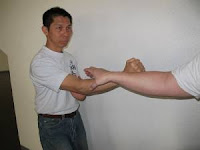Emei mountain , one of four holy Buddhist mountains
and third most significant kung place, right after Shaolin and Wudang .
According to some “sources” Emei kung fu is more than 2000 years old , first
styles emerged before fist Chinese dynasty and actually , Emei kung fu is the
oldest kung fu in whole China.
Other “sources” put creation of Emei styles
in different time periods , from prehistory to 17th century and many
of these “histories” include various legendary figures who can be found in
better known Shaolin and Wudang “histories”.
Emei kung fu styles are described as efficient
as Shaolin styles but also have internal component developed as much as it is
in Wudang styles if not more .
Some older sources are talking about only
one , single Emei style , while today there are undefined number of different
styles
When we give closer look at Emei kung fu
history one thing soon becomes pretty obvious. Creation myths(“histories”) about
Wudang and Shaolin are really detailed, there are large number of books that
cover this specific subject and at first glance these books leave an impression
they are written after serious historical and archeological research . Today we
know that classification to Wudang and Shaolin styles was invented in Goshu
academy during Republican period in China . Also it is very well known
fact Wudang and Shaolin were not places for
research and development of kung fu . Kung
fu was never practiced in Wudang before early 1930’s while in Shaolin martial
arts were practiced by individuals who brought them there , there was no
Shaolin kung fu .
Myth , actually group of stories about
origin of Emei kung fu are comparing to wudang and shaolin stories very short ,with
scant information , often contradict each other although these stories share
some common characteristics
This situation is not a surprise , just as
it is a case with Wudang and Shaolin creation stories , Emei creation stories
are pure fiction , with one significant difference , development time . While
stories about Wudang and Shaolin had almost a century to evolve ( first Shaolin
storiy can be found in 1905, wudang
stories are from early 1930’s ) and these places were and still are very
popular if not the most popular kung fu places , interest about Emei didn’t exist
until recently , although there are some mention about styles practiced on Emei
in republican period. No one talked about Emei until “kung fu craze” in the
late 1970”s and beginning of the 1980’s.
China was closed until recently and travel
to Emei was almost impossible and there were no practitioners of Emei kung fu
outside China (which is very peculiar). For these reasons there was no interest
for this styles therefore there was no need for any “histories”. Situation changed in last couple of decades,
China is open now and great number of people hurried and still hurry to find
and learn some exotic and still undiscovered styles hidden in inner China .Now
, when interest started to raise there was a need for “histories” because that
is very important for many people . On the other hand , there was not enough
time to developed “histories” in such detail like it was the case with other
two kung fu ‘centers”. Crude stories , with very little information and no
details , but with very clear message about what style is superior to all
others show that development time was short , most likely these stories were
written by single individuals to promote their styles and there was no time
(nor will) for information exchange , that is why stories are so different from
one another. Lack of details clearly shows that stories cannot be older than
one generation.
This , of course doesn’t mean that no kung
fu was practiced on Emei mountain .
Styles practiced there were common
styles for northen China like Pi Gua , long Fist, Tai Chi and many others but
we cannot talk about some specific group of Emei styles .
The truth is , until decade ago there were
not more than 10 kung fu practitioners on Emei mountain . During cultural
revolution, communist government killed a great number of kung fu masters and
few lucky survived but they couldn’t practice openly nor have students so
whatever they knew it was not passed to new generations.
It is also a truth that today new “old” ,
original , secret styles are discovered almost daily , together with new
grandmasters , masters ect. I think the rate of style discovering is proportional
to a number of foreign visitors. Closer look on that “old, original, secret”
styles clearly show that these styles are nothing more than modern wushu , sometimes
mixed with some of the traditional styles . Also it is obvious that all these
Emei masters, grandmasters and couches are professional wu shu performance
artists.
In the future it is highly possible that
some new “old, original:” center if kung fu will be discovered , when Emei
fashion pass and people start to search for something new and more exotic














